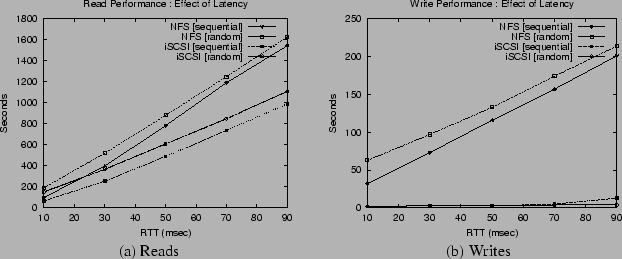 |

Our experiments thus far have assumed a lightly loaded Gigabit
Ethernet LAN. The observed round trip times on our LAN is very small
(![]() 1ms). In practice, the latency between the client and the server
can vary from a few milliseconds to tens of milliseconds
depending on the distance between the client and the server.
Consequently, in this section, we vary the network
latency between the two machines and study its impact on performance.
1ms). In practice, the latency between the client and the server
can vary from a few milliseconds to tens of milliseconds
depending on the distance between the client and the server.
Consequently, in this section, we vary the network
latency between the two machines and study its impact on performance.
We use the NISTNet package to introduce a latency between the client
and the server. NISTNet introduces a pre-configured delay for each
outgoing and incoming packet so as to simulate wide-area conditions.
We vary the round-trip network latency from 10ms to 90ms and study its
impact on the sequential and random reads and writes. The experimental
setup is identical to that outlined in the previous section. Figure
6 plots the completion times for reading and writing a
128 MB file for NFS and iSCSI. As shown in Figure
6(a), the completion time increases with the network
latency for both systems. However, the increase is greater in NFS
than in iSCSI--the two systems are comparable at low latencies
(![]() 10ms) and the NFS performance degrades faster than iSCSI for
higher latencies. Even though NFS v3 runs over TCP, an Ethereal trace
reveals an increasing number of RPC retransmissions at higher latencies.
The Linux NFS client appears to time-out more frequently at higher latencies
and reissues the RPC request, even though the data is in transit, which in turn dregrades performance.
An implementation of NFS that exploits the error recovery at the TCP layer
will not have this drawback.
10ms) and the NFS performance degrades faster than iSCSI for
higher latencies. Even though NFS v3 runs over TCP, an Ethereal trace
reveals an increasing number of RPC retransmissions at higher latencies.
The Linux NFS client appears to time-out more frequently at higher latencies
and reissues the RPC request, even though the data is in transit, which in turn dregrades performance.
An implementation of NFS that exploits the error recovery at the TCP layer
will not have this drawback.
In case of writes, the iSCSI completion times are not affected by the network latency due to their asynchronous nature. The NFS performance is impacted by the pseudo-synchronous nature of writes in the Linux NFS implementation (see Section 4.5) and increases with the latency.